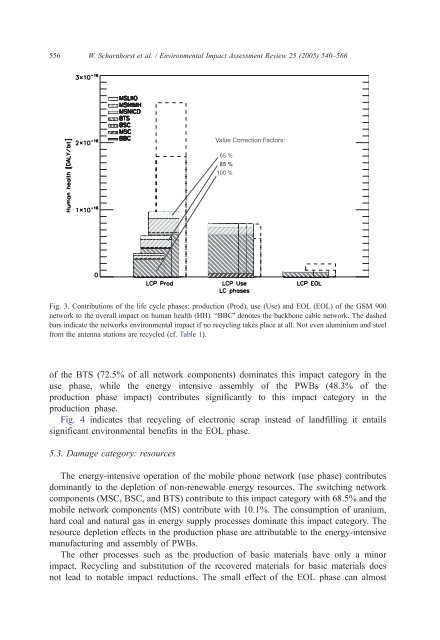The end of life treatment of second generation mobile phone ... - Empa
The end of life treatment of second generation mobile phone ... - Empa
The end of life treatment of second generation mobile phone ... - Empa
You also want an ePaper? Increase the reach of your titles
YUMPU automatically turns print PDFs into web optimized ePapers that Google loves.
556W. Scharnhorst et al. / Environmental Impact Assessment Review 25 (2005) 540–566Value Correction Factors:65 %85 %100 %Fig. 3. Contributions <strong>of</strong> the <strong>life</strong> cycle phases: production (Prod), use (Use) and EOL (EOL) <strong>of</strong> the GSM 900network to the overall impact on human health (HH). bBBCQ denotes the backbone cable network. <strong>The</strong> dashedbars indicate the networks environmental impact if no recycling takes place at all. Not even aluminium and steelfrom the antenna stations are recycled (cf. Table 1).<strong>of</strong> the BTS (72.5% <strong>of</strong> all network components) dominates this impact category in theuse phase, while the energy intensive assembly <strong>of</strong> the PWBs (48.3% <strong>of</strong> theproduction phase impact) contributes significantly to this impact category in theproduction phase.Fig. 4 indicates that recycling <strong>of</strong> electronic scrap instead <strong>of</strong> landfilling it entailssignificant environmental benefits in the EOL phase.5.3. Damage category: resources<strong>The</strong> energy-intensive operation <strong>of</strong> the <strong>mobile</strong> <strong>phone</strong> network (use phase) contributesdominantly to the depletion <strong>of</strong> non-renewable energy resources. <strong>The</strong> switching networkcomponents (MSC, BSC, and BTS) contribute to this impact category with 68.5% and the<strong>mobile</strong> network components (MS) contribute with 10.1%. <strong>The</strong> consumption <strong>of</strong> uranium,hard coal and natural gas in energy supply processes dominate this impact category. <strong>The</strong>resource depletion effects in the production phase are attributable to the energy-intensivemanufacturing and assembly <strong>of</strong> PWBs.<strong>The</strong> other processes such as the production <strong>of</strong> basic materials have only a minorimpact. Recycling and substitution <strong>of</strong> the recovered materials for basic materials doesnot lead to notable impact reductions. <strong>The</strong> small effect <strong>of</strong> the EOL phase can almost
















